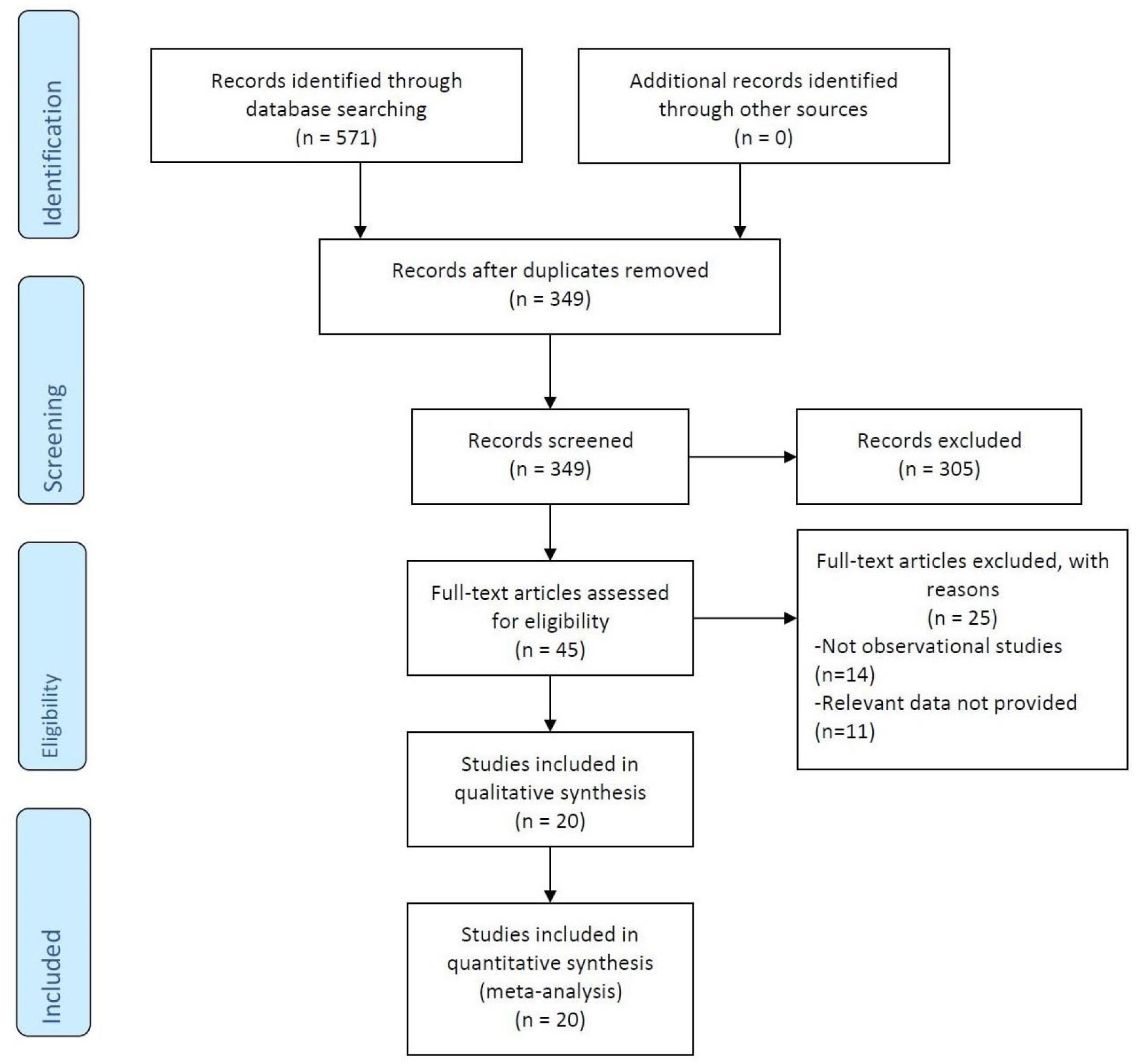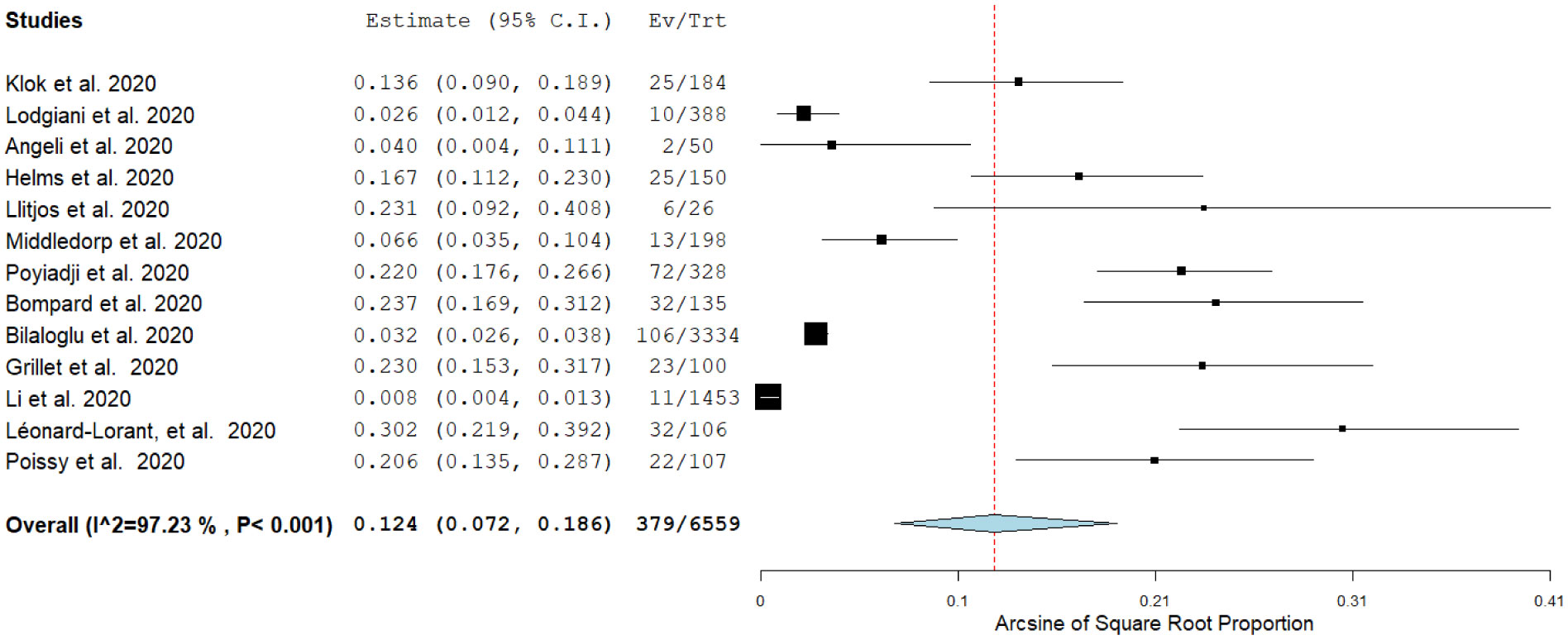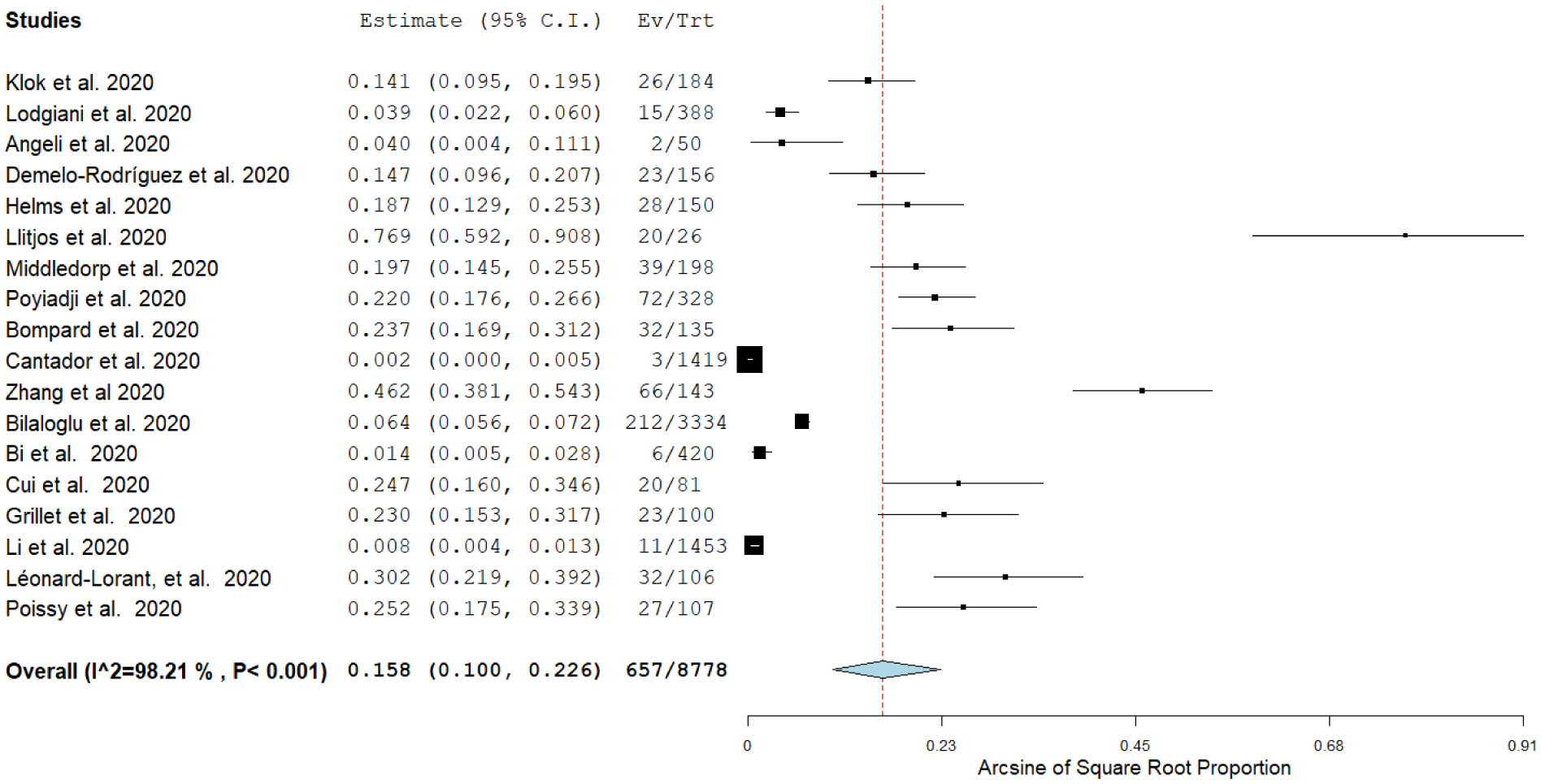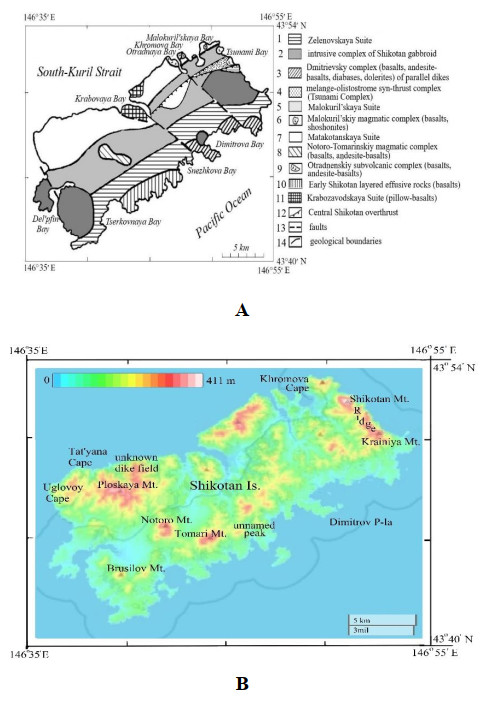In this paper, for the first time, we used Google Earth, an easily accessible method for obtaining geological information to study Shikotan Island (Lesser Kuril Arc). Google Earth flight mode made it possible to examine coastal cliffs on the island, which are inaccessible for hiking or walking, whereas 3-D visualization mode helped us study topographic features, tectonic dislocations, and sediment layering hidden by vegetation and soil, thereby significantly expanding understanding of the geologic structure of the island. Researchers conducting studies in the northwestern part of the island (Tat'yana Cape) discovered a previously unknown structure—a dike field. In the southern part, two thrust faults were identified: An unnamed peak and Tomari Mountain, previously considered a volcano. In the southwestern part of Shikotan Island, there are four unknown volcanic peaks. Together with the Notoro Volcano, they mark the rim of an interpreted caldera of a paleovolcano, which could have been the main unknown source of tuffaceous material for the Mesozoic-Cenozoic deposits of the Matakotanskaya, Malokuril'skaya, and Zelenovskaya Suites. It has been shown that the gabbroid massif of Tsunami Bay (northeastern part of the island) is an autochthonous (local) formation, and not allochthonous, that is, brought from the Pacific Ocean, as evidenced by an intrusive contact with the rocks of the Malokuril'skaya Suite. Despite these positive results, analysis of satellite images of Shikotan Island unexpectedly has not confirmed the existence of the Central Shikotan thrust fault, the largest previously mapped tectonic structure on the island. This work confirms that Google Earth is a very useful tool for geological research in remote areas.
1.
Introduction
Infection with severe acute respiratory syndrome coronavirus 2 (SARS-CoV-2) might put patients at a risk of venous and arterial thrombosis [1]. A thrombus is a solid mass composed of platelets and fibrin with a few trapped red and white blood cells that forms within a blood vessel. Its formation is potentiated by either a hypercoagulable state or obstruction. SARS-CoV-2 uses angiotensin converting enzyme 2 (ACE2) receptor for entry into endothelial cells and replicates, which causes infiltration of inflammatory cells, endothelial cell death, and prothrombotic effects in the microvasculature. This may lead to systemic hypercoagulability and increased risk for thromboembolic events [2]. There are a number of studies highlighting the occurrence of thromboembolism in COVID-19 positive patients. However, these studies have reported varied findings. Therefore, this meta-analysis would help us analyze the prevalence of thromboembolic events in the hospitalized COVID-19 patients.
2.
Methods
PubMed and SCOPUS were searched up till July 21, 2020 using the following keywords and their MeSH terms: “COVID-19”, “Thromboembolism”, “Pulmonary Embolism”, “Deep Venous Thrombosis”, “Stroke”, “Myocardial Infarction”. Two reviewers (SSA and AA) independently conducted the literature search. A third reviewer was consulted to resolve any conflict faced by the two authors. We included retrospective, cross-sectional, case-control, and cohort studies on COVID-19 hospitalized patients that reported the incidence of thromboembolic events. Both genders were included and there was no age limit. We included studies that were published in English only. The studies that did not report the incidence of thromboembolic events and which were conducted in out of hospital patients were excluded. Initially, 571 potential studies were identified from the search strategy. PRISMA flow chart (Figure 1) summarizes our literature search [3]. After exclusions based on sequential screening of titles, abstracts, and full-texts, 20 studies (Table 1) were included. The outcomes of interest were presence of pulmonary embolism (PE), deep vein thrombosis (DVT), stroke, and myocardial infarction (MI). Outcomes were presented as proportions. Arcsine of square root proportions and corresponding 95% confidence intervals (CI) were pooled using a random effects model. P value <0.05 was considered significant.
3.
Results
The analysis includes 20 studies (Table 1) with a total of 15,452 patients [4]–[23]. The incidence of venous thromboembolism was found to be greater than arterial thromboembolism. Amongst the studied thromboembolic events, the prevalence of pulmonary embolism (PP: 12.4% [7.2%, 18.6%]; I2 = 97.23%) was the highest. It was followed by deep vein thrombosis (PP: 8.6% [4.2%, 14.3%]; I2 = 97.52%), myocardial infarction (PP: 2.3% [0.2%, 11.2%]; I2 = 99.3%), and stroke (PP: 1.2% [0.8%, 1.6%]; I2 = 65.09%), (Table 2 and Figue 2, 3, 4, and 5). The Forest plots (Figure 6) show the combined incidence of arterial thromboembolism including MI and stroke (PP: 2.5% [0.2%, 0.7%]; I2 = 98.91%). Figure 7 shows Forest plots of venous thromboembolism, including pulmonary embolism and deep venous thrombosis (PP: 15.8% [10.0%, 22.6%]; I2 = 98.21%).
4.
Discussion
The results of this meta-analysis demonstrate that pulmonary embolism is the most prevalent thromboembolic event in COVID-19 hospitalized patients. This finding concurs with that of prior studies, such as that by Al-Ani et al. where they reported a high frequency of PE, along with an overall venous thromboembolism (VTE) frequency of 20% of patients, and of stroke 3% [24]. Klok et al., which was an analysis of incidence of thromboembolic events in critically ill COVID19 patients in three Dutch hospitals, reported a cumulative incidence of 31%, with the highest being that of PE [25]. This high prevalence of PE can be attributed to the hypoxia induced coagulation leading to an in-situ thrombosis [24]. In contrast, studies on hospitalized patients without COVID-19 have generally shown a lower incidence of VTE. A study on VTE (reporting DVT and PE) risk stratification in patients without COVID-19 reported a low incidence of 0.3% of VTE development during hospital admissions [26]. Another study reported the trends in the incidence of PE and DVT in hospitalized patients over the course of 20 years. The incidence in DVT amplified from 0.8% to 1.3% of admissions while the incidence of PE was 0.4% and remained constant [27]. This suggests that the virus may increase the risk of thrombosis. However, further investigation is needed to confirm this. Post-mortem findings in COVID-19 patients have shown evidence of subclinical thromboembolism, mainly in the pulmonary vasculature [28]. DVT thromboprophylaxis is recommended in all hospitalized patients but the guidelines for prophylaxis in COVOD-19 are heterogenous [24]. In COVID-19 patients with severe disease and elevated D-dimer levels, heparin use was found to decrease mortality. This benefit was not seen in non-COVID pneumonia patients admitted to intensive care unit [29]. Apart from PE, COVID-19 can also be complicated by DVT, MI and stroke as the continued inflammatory response to COVID-19 with cytokine overproduction, raised D-dimer levels and fibrin degradation products leads to a prothrombotic state [30]. Increased risk of myocardial infarction is also seen in influenza and other virus illness [31]. Myocardial infarction can also be the first presenting feature of COVID-19 [32]. A rise in catecholamines due to the systemic inflammation in COVID-19 can cause plaque disruption and acute myocardial infarction [33]. Myocardial infarction due to COVID-19 can also occur in the absence of a culprit lesion in the coronary artery [32]. Compared with other anticoagulation medicines, low molecular weight heparin (LMWH) is associated with better prognosis in COVID-19 patients [33]. Tissue plasminogen activator (tPA) can be considered in patients with COVID-19 associated acute respiratory distress syndrome who are on mechanical ventilation [33]. Rapid rising data on varied neurological symptoms associated with Covid-19 individuals emphasizes more on the risk of thrombotic vascular events associated with this disease course. A rapid review on Covid-19 related stroke in young individuals reported that SARS-CoV-2 is more likely to cause stroke than the other coronavirus and seasonal infectious diseases [34]. In fact, a 7.5-fold increased rate of cerebrovascular events is documented in nearly 1.5% covid-19 hospitalizations than in patients with influenza [35].
Due to the lack of sufficient data, we were unable to analyze the impact of baseline factors such as age and sex on our results. This meta-analysis included COVID-19 hospitalized patients and does not represent all the patients with COVID-19, including asymptomatic carriers and patients who are treated at home. The studies are heterogenous and include studies with self-reported outcomes which increases the risk of bias. Due to difference in pathophysiology, prophylaxis and treatment of arterial and venous thrombotic complications, more studies are required to fill the gap in this area. The impact of treatment and drugs administered on these outcomes was not taken into account in this analysis.
5.
Conclusion
Based on the results of our meta-analysis, thromboembolism may prove to be a significant factor in the pathogenesis of COVID-19. These complications should be anticipated in patients with COVID-19 and effective treatment should be given. Use of thromboprophylaxis should be considered to reduce the risk of thromboembolism [25]. Future studies should focus on establishing a link between the severity of COVID-19 infection and its thromboembolic complications. Serum markers should be identified which relate to increased risk of thromboembolic complications and worse prognosis. The dose and mode of thromboprophylaxis should also be studied to improve outcomes in COVID-19 patients.










 DownLoad:
DownLoad:
















